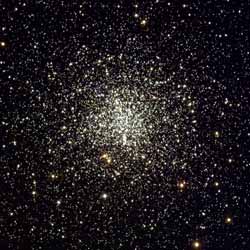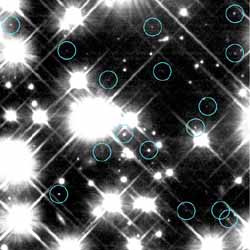
Astronomers have peered deep into the globular cluster M4 to identify the oldest white dwarfs in the universe.
Courtesy NOAO/AURA/NSF.
Ever since the theory of the Big Bang came to the fore, astronomers have known that the universe had a beginning, and thus, a birth date. But figuring out just how many candles to put on the universe's birthday cake has proven tricky.
In recent years, thanks to the worldwide efforts of astronomers using the Hubble Space Telescope and other instruments, the age of the universe has been narrowed down to 13–14 billion years. This week, an independent study led by Harvey Richer (University of British Columbia), confirmed that result and put a strong lower bound of 12–13 billion years on the age.
Richer's team looked to white dwarfs to reach their age estimate. They peered deep into the globular cluster M4 in Scorpius with the Hubble Space Telescope to identify the dimmest, coolest, and therefore oldest white dwarfs. These 30th-magnitude objects were among the first stars to form in the cosmos.
When a Sun-type star reaches the end of its lifetime and sheds most of its outer gasses as a planetary nebula, the remaining core — a white dwarf — slowly cools for billions of years to come. The rate of white dwarf cooling is well understood. Cooler than a certain temperature, no additional white dwarfs were found. Richer used the temperature cutoff point of the dying stellar embers to determine their ages.
"What we have done is look at [white dwarfs] in the most ancient star clusters that we could find, and we [identified] the coolest and dimmest of these to derive an age," says Richer.

Within this Hubble Space Telescope close-up view into M4 are many white dwarfs (circled). The oldest date back 12 or 13 billion years, setting a minimum age for the cosmos. Click on image for wide-field view.
Courtesy NASA/ H. Richer.
From measurements of 600 dwarfs, Richer finds that the oldest are between 12.7±0.7 billion years old. Current theories of galaxy and star formation suggest that about one billion years passed between the Big Bang and the birth of the stars now seen as these white dwarfs — yielding a total cosmic age of nearly 14 billion years.
The most definitive age determination study to date is often thought to be the Hubble Space Telescope Key Project to measure the Hubble Constant. Wendy Freedman (Carnegie Institution of Washington) led the project, which measured the rate of the universe's expansion to be 72 kilometers per second per megaparsec. From that finding (and taking into account the accelerating rate of the expansion due to the recently discovered dark energy), Freedman's team derived an age of the universe of around 14 billion years.
"The fact that [the ages] are in the same ballpark is an interesting result," says Freedman.
Richer's work will be published in an upcoming issue of Astrophysical Journal Letters.
 0
0
Comments
You must be logged in to post a comment.